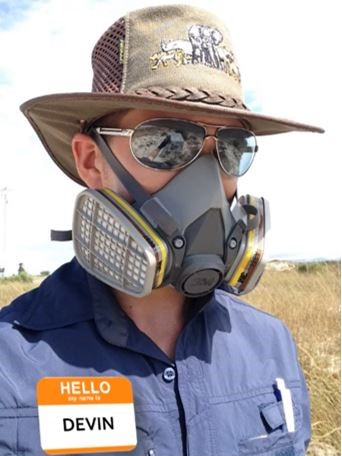Dr Finaughty started the first taphonomic research programme in Cape Town, South Africa for his PhD. He discussed this and the broader challenges that taphonomic research facilities face globally, writes President of the UKC Anthropology Society, Carl Grevel.
Dr Devin Finaughty was a senior member of FACT (Forensic Anthropology Cape Town), and co-founded a laboratory in 2015 with a specific focus on forensic taphonomy. He is currently a Lecturer in Biological Anthropology at the University of Kent.
Finaughty gave the excellent ‘Body Farms’ talk this month to the UKC Anthopology Society. He explained that there are 10 (since time of writing: there are now 12) human taphonomy facilities globally, and many more that use non-human animals as surrogates. In Cape Town, the murder rate is very high, and the majority of these murders take place on the Cape Flats, where there are extremely dire socio-economic circumstances and high levels of interpersonal violence. This area has a very specific climate, and therefore subject to a very specific type of decomposition.
Dr Finaughty mentions that it was very difficult to find a place to start a taphonomic research programme in Cape Town, as it had to be near the city, but removed from residential areas as it would be a biohazard.
When looking for a location, Finaughty approached numerous potential hosts for land -all were unable to help. Finally, a private facility on the Cape Flats was able to provide some land which met the requirements of the project perfectly.
Dr Finaughty explained that his taphonomic research programme was to use pig carcasses for its research.
The pigs were to be put into huge 80kg wire mesh cages. Getting all the equipment together was very difficult, Dr Finaughty explained. There were a lot of relationships with suppliers that had to be created in order to buy weather stations, camera traps, monitors, weighing equipment etc. It was very expensive and Dr Finaughty had to initially put in his own money before a grant he had applied for was able to pay him back.
Because of the back breaking work that was carrying all the equipment to obtain taphonomic data, a research assistant was hired in the second half of the project. A large element of the research had to change as Cape grey mongooses were able to sneak into the pig cages (designed to inhibit scavenging) and begin scavenging the carcasses. In the end, however, the mongoose scavenging was factored into the research and for the next 3 and a half years, Dr Devin Finaughty painstakingly carried out 458 days of data collection.
Challenges:
Taphonomic research programmes are often not in the most ideal locations, they can be really far into the mountains (Colorado: FIRS) or out into the middle of nowhere (Australia: AFTER), may not necessarily represent forensically relevant areas (though this does not diminish the value they contribute to forensic taphonomic research). These facilities are also very expensive, and as a result tend to be permanent. This permanence can be a problem because at a certain point you’ve “scorched the earth” and decomposition will be altered, mentions Dr Finaughty. So in places like ARF (at the University of Tennessee) that have been active for almost 40 years, is the area still a baseline environment? For example, have local scavengers become habituated to the donated remains? How can this be proven?
In general there is also a lack of standardisation in forensic taphonomy. Dr Finaughty is on an international committee trying to tackle this problem. A lot of the issues that need standardisation are related to realistic representation: What size carcass to use? Should we use human or animal remains? Enclosed in a cage or out in the open? How far apart should bodies be? Should remains be clothed?
In current taphonomic research, a lot of the data gathered is qualitative as well, and there should be a move away from this. Finaughty foresees a move towards automation that would, for example, record temperature and weight much more frequently and more rigorously than is possible using manual data collection methodologies, and without human involvement. (As visiting a site every day to collect data will alter local scavenging behaviour and disrupt the decomposition process.)
Ethics is another large issue. Dr Finaughty talked about how the relevant legislation to a human taphonomic facility is different in each country, for example in South Africa the National Health Act does not provide for it, in the UK there is an argument about whether the Human Tissue Act applies or not. There is also the question of consent when it comes to human donations. Can anyone who has donated their body to science be used in human taphonomic studies, or only when specified? To make matters more confusing, public perception is one of the biggest considerations in the establishment of taphonomic research facilities as politicians and regulators need to work within the scope of public approval.
When considering the future of taphonomic research programmes, Finaughty mentioned that a portable and automated research station might lie in the future. This way a single location will only be temporarily used for taphonomic research and the research will be able to be conducted in many locations in a shorter period of time.
Relevant papers:

